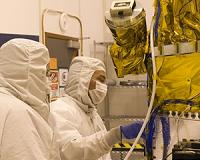 |
Pasadena CA (JPL) Nov 25, 2010 While most Americans are traveling to family gatherings this week for Thanksgiving, a team of scientists from NASA's Jet Propulsion Laboratory, Pasadena, Calif., and the Goddard Space Flight Center in Greenbelt, Md., are flying down to Brazil to "cook" a salty NASA instrument that's sure to spice up studies of Earth's climate after its launch late next spring. NASA's Aquarius instrument and the Argentinian spacecraft that will carry it into space, the Satelite de Aplicaciones Cientificas (SAC-D), were moved into a thermal vacuum chamber at Brazil's National Institute for Space Research (Laboratorio de Integracao e Testes - Instituto Nacional de Pesquisas Espaciais, or LIT-INPE) in Sao Jose dos Campos on Nov. 15, in preparation for a series of environmental tests. The thermal vacuum tests will confirm the integrity of the spacecraft's electrical connections and will subject the instruments and spacecraft to the extreme hot, cold and airless environment they will encounter once in orbit. Aquarius/SAC-D is an international mission involving NASA and Argentina's space agency, Comision Nacional de Actividades Espaciales. Aquarius, the JPL-built primary instrument on the mission, is designed to provide monthly global maps of how the concentration of dissolved salt (known as salinity) varies on the ocean surface. Salinity is a key tracer for understanding the ocean's role in Earth's water cycle and tracking and understanding ocean circulation. By measuring ocean salinity from space, Aquarius will provide new insights into how the massive natural interplay of freshwater moving among the ocean, atmosphere and sea ice influences Earth's ocean circulation, weather and climate. The minimum three-year mission is scheduled to launch in late spring of 2011 from Vandenberg Air Force Base, Calif.
Share This Article With Planet Earth
Related Links Aquarius Space Technology News - Applications and Research
 Glory Team Overcomes Engineering Obstacles
Glory Team Overcomes Engineering ObstaclesWashington DC (SPX) Nov 25, 2010 Engineers have faced and overcome a number of unique challenges in recent years while preparing NASA's newest climate-monitoring mission for launch. Yet the engineering has begun to gel, and engineers are now reaching the final stretch of their effort to prepare the Glory spacecraft for launch. For a few dozen of the engineers who work on the mission, the task begins every morning with an ... read more |
|
| The content herein, unless otherwise known to be public domain, are Copyright 1995-2010 - SpaceDaily. AFP and UPI Wire Stories are copyright Agence France-Presse and United Press International. ESA Portal Reports are copyright European Space Agency. All NASA sourced material is public domain. Additional copyrights may apply in whole or part to other bona fide parties. Advertising does not imply endorsement,agreement or approval of any opinions, statements or information provided by SpaceDaily on any Web page published or hosted by SpaceDaily. Privacy Statement |